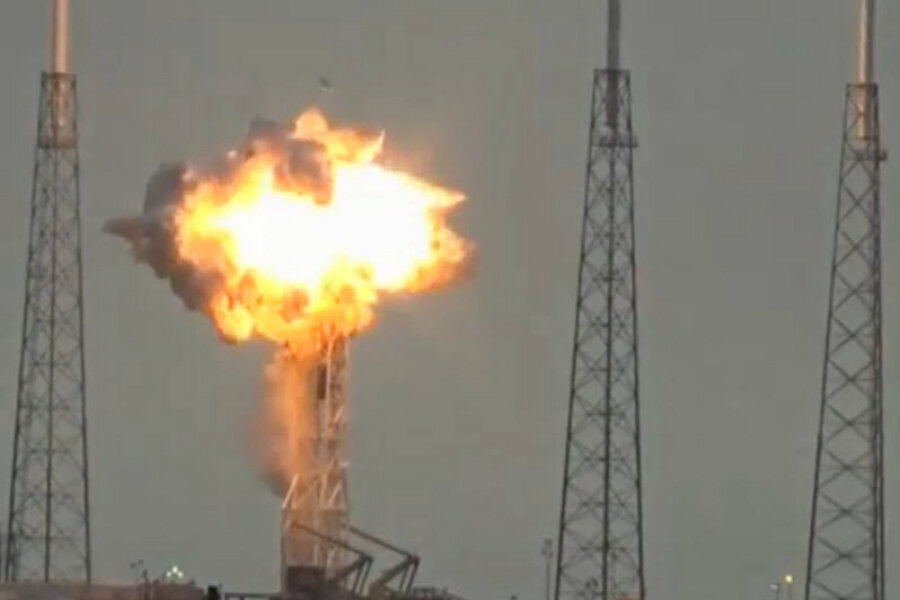Is SpaceX's 'punishing schedule' too ambitious?
Loading...
Elon Musk is most comfortable on the cutting edge. From cars to spaceflight to solar energy, it’s no secret that the entrepreneur likes to push the envelope.
But the explosion of a SpaceX rocket last week raises the question: Is the CEO pushing too hard?
A semi-reusable Falcon 9 rocket, one of several built by Musk’s SpaceX firm to deliver payloads to the International Space Station, exploded during a routine firing test at Cape Canaveral Air Force Station on Thursday. The craft was slated to carry an Israeli communications satellite into orbit this week.
SpaceX has attributed the malfunction to an “anomaly” on the launch pad. Some industry experts, such as former NASA official Scott Pace, expressed concern after the company’s failed launch.
“SpaceX is running a punishing schedule,” Pace, who is now the director of the Space Policy Institute at George Washington University, told The New York Times. “There is probably some human factor involved here. To what extent was human error part of this? And if so, why? Are you running your people too hard? What are your safety requirements?”
But NASA and other experts have stressed that, given the scope of the company’s work, scattered mishaps are normal. Even after Thursday’s explosion, SpaceX’s success rate hovers near the mid-90 percent range.
Sometimes, you just have to break a few $60-million eggs to make a space omelet.
"With space missions, even the most advanced simulations cannot replace learning by doing, given the multitude of variables involved and the importance of learning from experience," Loizos Heracleous, a Warwick Business School professor who has worked with NASA, told The Christian Science Monitor in an email. "This explosion will not change the long term goals of SpaceX, which are to reduce the cost of spaceflight through the use of reusable rockets, and eventually to colonise Mars."
This wasn’t the first SpaceX rocket to meet its end at Cape Canaveral. In 2015, an ISS-bound Falcon 9 rocket bearing more than 2 tons of cargo exploded just 139 seconds after launch. In the wake of a long string of successful launches, the loss was a considerable setback for the aerospace company. But NASA officials remained confident in the agency’s partnership with SpaceX.
"We've always assumed we would lose a vehicle every so often," then-ISS program manager Michael Suffredini said in a press conference after the incident. "Getting to low-Earth orbit is extremely challenging."
SpaceX bounced back quickly after the 2015 explosion. Aside from a temporarily delayed launch schedule and a destroyed rocket, the consequences of that failure were relatively benign. But while both incidents may sound similar, there are a few crucial differences that could cause trouble for the company going forward.
This time, SpaceX didn’t just blow up a rocket – it also destroyed a $195-million satellite, and dealt Facebook a major setback in the process. The satellite, which was built by Israeli company Spacecom, was comissioned by Facebook as part of its Internet.org initiative, which aims to bring wireless connectivity to remote and impoverished areas.
What’s more, the malfunction follows in the wake of bad press for Musk’s other brainchild, Tesla Motors. In this year alone, Tesla missed delivery deadlines and was linked to a fatal “Autopilot” crash. Linked by Musk’s ownership, the two companies could have a negative mutual effect on each other.
“When all is said and done, does it have any impact on Tesla stock? No,” Trip Chowdhry, a senior analyst at Global Equities Research, told The New York Times. “But events at SpaceX do create headline risk for Tesla stockholders.”
The failure will also delay SpaceX’s own operations. The company has two remaining launch pads, but neither is capable of sending space station payloads. Any rocket that takes off from the firm’s California launch site would need to fly over populated land to reach ISS – a no-go for modern spaceflight. And a second pad at Cape Canaveral will not be fully operational until November.
[Editor's Note: This report has been updated to correct the number of fatal crashes involving Tesla's "Autopilot" feature.]






